Okay, let’s get the jokes out of the way now. No, this isn’t a game where the first person to get caked with urine loses. No, this isn’t a contest to see who has the longest stream and yes, crossing them would mean that all life as you knew it would stop instantaneously and every molecule in your body would explode at the speed of light…a total protonic reversal. I’ll wait while you Google that…
Wiz-War is a competitive board game, and a chaotic one at that. You take on the role of a wizard who’s trying to defeat all of the other wizards on the board. The goal is to be the first wizard to two points or the last wizard standing, whichever comes first. When a wizard is taken out, he’s eliminated from the game.
Every wizard (red, blue, green, or yellow) has their own player board. These player boards have different layouts to keep things interesting. Players are assigned a random wizard color to encourage players to not get attached to a particular board layout. On top of that, player boards are two sided…one side being the classic version (from years ago) and one side being the newer version. It’s important that players do not mix and match versions…be sure to decide on which version you’d like to use before you play. The difference lies mainly in the layout of the walls and the starting locations of your treasure tokens…so it’s not that big of a deal.
Players then combine all of the colored boards of the wizards who are playing to form the dungeon. Rotate the boards randomly to keep the layouts different from game to game. The board also has portals that players can step through to travel quickly to other parts of the dungeon. The manual explains how to set up the portals and combine the boards, so it’s not as complicated as it sounds.
The game features multiple schools of magic, each with their own deck. Players choose up to four schools of magic to form the main deck that everyone will draw from throughout the game. Alternate rules allow players to choose particular / unique schools of magic that only they draw from. In this case, one wizard might choose Mutation and Alchemy, whereas another might choose to specialize in Elemental and Conjuring.
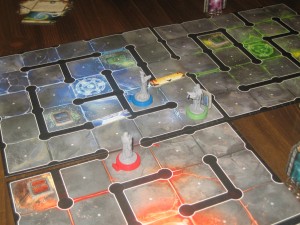
Some objects in the environment are destructible, like walls. Likewise, some cards allow you to create objects that can be either harmless (like stone walls) or dangerous (like walls of fire).
Players take turns moving, attacking, and drawing new cards. Their goal is to steal treasure tokens from their opponents and bring them back to their home square to score points. Players receive one point for each treasure successfully stolen, though an opponent can steal that same treasure right back, robbing them of the victory point. A player who kills another is awarded a permanent victory point. Players are given a hitpoints counter to keep track of how close to death they are. Whoever gets two victory points or is the last wizard standing wins.
The real meat and potatoes of the game are the cards you play. Some cards are attack cards, some cards are counter cards which act like interrupts, some cards are item cards which you permanently carry for a bonus, and some cards are neutral spells that alter gameplay in some fashion. There are also energy cards that can boost your movement speed (how many spaces you can go) and improve the duration or power of a spell. Energy cards can turn a simple fireball card into a powerhouse that can knock off half of your health in one hit.
It can be overwhelming at first to get used to how all of the cards play out. We often spent a minute reading cards aloud along with the interrupt to see the net effect, taking into account line of sight and energy cards that can be played to boost power to certain spells. Once players get used to how to cards work together, gameplay is quick and smooth. Until then, expect to spend a minute or two scratching your head trying to figure out how an odd card is meant to be applied. I had / have the same issue with Magic the Gathering…lots of cards and lots of special rules to take into account. Luckily, Wiz-War is light compared to Magic the Gathering in terms of card variety and complexity.
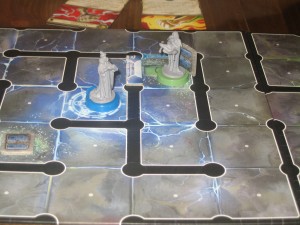
I had just taken my son’s treasure and to prevent him from getting to me, I threw up a stone wall. He got his revenge by moving back a step and casting a “destroy wall” card which damaged me for two hitpoints.
My eleven year old, Vinnie, had some difficulty with understanding the cards’ effects. Perhaps as we play more games he may get used to them. He was also frustrated when his wizard was eliminated…this game can lead to a bit of bad sportsmanship if you’re the sore loser type. I can tell he wasn’t happy when he was eliminated…to be fair, he had no qualms about punching me with a metal gloved item and a fire cloak for seven damage. Regardless, he enjoyed the overall experience. He said that his favorite part was figuring out how best to move your wizard and attack based on the kinds of attacks you had available. The strategy aspect of combat really had him engaged.
Anthony, the sixteen year old, won the game by the skin of his teeth. It was a close battle between the two of us until he drew a lifestone item card that replenished one health per turn. No matter how many firewalls I threw up and electric bolts I hit him with, I could never kill him…I came very close but he won through attrition with his constant life replenishment. He said that he enjoyed the combat element and all the different cards you could play to kill the other wizards.
Personally, I think the game is OK…I like it and I dislike it. I like it because the game has a Magic the Gathering vibe to it and is light to boot. There’s enough variety in the cards to make things interesting. With that said, the cards you draw are random…if you end up getting a lot of crappy neutral spell cards with no attacks or interrupts, players can wail on you without you having much in the way of defending yourself. Personally, I drew a lot of interrupts so I was able to block attacks left and right but I didn’t see a lot of attack cards, forcing me to make a run for treasures for my points. The random luck of the draw can ruin even the best wizard’s day. By the same token, some players may enjoy the random chaos that comes from such a mechanic. This game would be best for players who aren’t all that competitive and just enjoy a semi-casual dungeon battle. Young children may be confused and overwhelmed by the cards themselves and highly competitive players may get postal when random luck takes a dump all over their best laid plans.
If you’re someone who isn’t turned off by games that require a lot of card reading (like Magic the Gathering, Dominion, Innovation, etc) and you don’t mind chaos and random luck sometimes taking the driver’s seat, then by all means, pick this up.
Final Verdict: 7/10

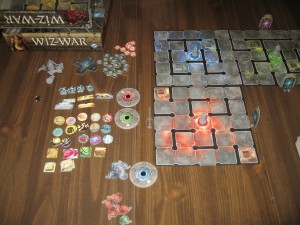
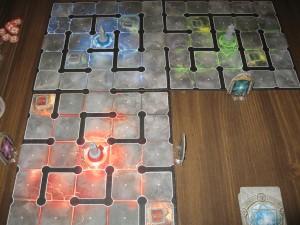
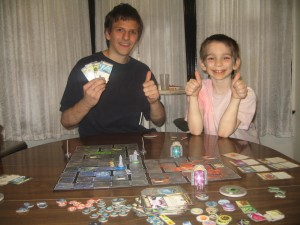
Thanks for taking the time to make a review. My daughter and me have been trying to get our heads around the instructions, I wish there was a video tutorial or play through as I am sure the instructions are way more convoluted than they need to be. The game looks great though.
You’re welcome, and thanks for taking the time to read it! I’d like a video tutorial as well, the game took me a while to figure out and on our first playthru I’m sure I missed a rule or two. Once players get used to the cards it becomes a bit easier, but for first time players it can be overwhelming…it was for us anyway. 🙂 It’s a fun game, but there are more user-friendly ones out there better suited for younger kids. If you and your daughter are able to play without worrying about getting all the rules right, it may work out for you! The kids were more concerned with blowing me up than keeping all the rules straight, and we still had fun anyway.
I see you didn’t like some aspects of the game because of bad draws and too many counter spells. To fix that just pull out a lot of the counterspell cards and life adding spells and you’ll a game that’s closer to a 10 rating. Oh and pool all your cards together. You can find the variant decks on boardgamegeeks.